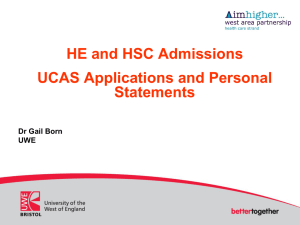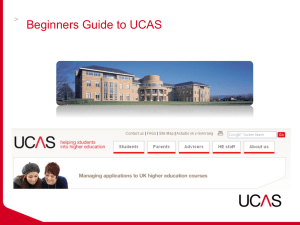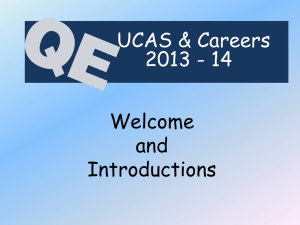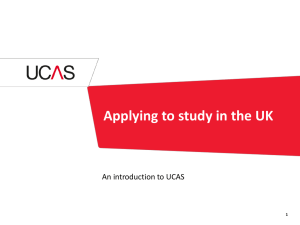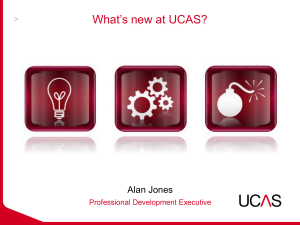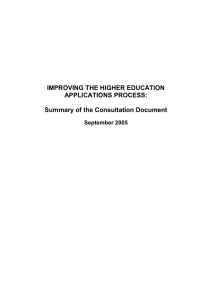AnthonyMcClaranHEPI7.12.05
advertisement
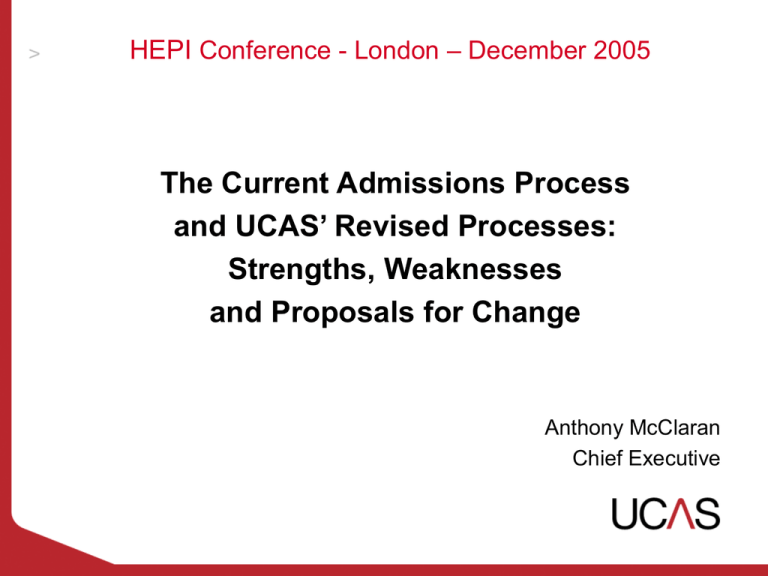
HEPI Conference - London – December 2005 The Current Admissions Process and UCAS’ Revised Processes: Strengths, Weaknesses and Proposals for Change Anthony McClaran Chief Executive Overview Historical perspective Current application process Strengths and weaknesses Revised processes Future challenges and change Questions and answers Historical perspective 1961 - UCCA formed 1985 - PCAS formed 1991 - White Paper: ‘Higher Education – A New Framework’ i. UCCA & PCAS combined to form UCAS ii. Significant expansion of numbers iii. Ending of binary line iv. Underlying purpose:- fair & efficient management of the admissions process Charity status – owned by member institutions Historical perspective 1966 90,900 applicants – 44,500 acceptances 63 institutions 2005 520,900 applicants – 405,000 acceptances 325 institutions GTTR NMAS CUKAS Current application process Initiated over 40 years ago Well-established, central and standardised Applications made to undergraduate full-time courses Widely used: i. > 500,000 applicants ii. > 6,000 schools and application centres iii. 189 member universities/HE colleges iv. 136 member FE colleges Strengths and weaknesses Strengths Understood and respected Independent and impartial Balances needs of applicants, schools and HEIs Linked, via UCAS, to extensive information sources Minimises barriers Provides data and management information Gives assurance to both applicants and institutions Strengths and weaknesses Weaknesses Included aspects of older, legacy systems Non-uniform information technology standards Limited opportunity for differentiation Challenge of market-based competitors Restriction of student choice Has to support wide variety of admissions practice Revised processes “Technical changes lie ahead. They may eventually involve the inclusion of the whole contents of the application form in the on-line traffic with the universities …. We may also see the development of on-line exchanges with the schools, perhaps even with individual candidates, as personal microcomputers increasingly come into daily use….” Ronald Kay, General Secretary, UCCA, 1985 Revised processes Electronic systems at UCAS Old system i. Over 20 years old with variety of additions and operating software ii. Incompatible with more modern systems iii. Lacked readily available operational and maintenance expertise New system i. Integrated applicant-facing services ii. Industry-standard, robust central operating system iii. Electronic interface with HEIs Revised processes What does it mean for applicants? Advisers can view progress in completing applications on line Applicants can complete application independently Accuracy checks built into the system Fast processing of application by UCAS with acknowledgement letter normally dispatched within 24 hours Applicant can ‘Track’ subsequent progress Revised processes What does it mean for HEIs? Rapid transmission of applications to HEIs HEIs can load applicant data straight into their own systems Rapid notification of offers to applicants Capacity for considerable additional information to be submitted and transmitted to HEIs Revised processes Benefits for the sector Addresses identified weaknesses Facilitates a ‘joined-up’ application process Speed Access to real-time data Future-proof (e.g. adaptable to PQA) Potential for 100% electronic applications (Currently running at 98% for UCAS 2006 entry cycle) Future challenges and change Differentiation: i. New forms of evidence ii. Unit grades iii. Admissions tests Widening Participation Professionalism Tuition fees, bursaries and scholarships PQA Percentage of A level Scripts Achieving Grades 100% 95% A-E 90% 96.2% 85% 80% 75% 30% 25% A 22.8% 20% 15% 10% ’92 ’94 ’96 ’98 ’00 ’02 ’04 ’05 Source: Inter Boars Statistics 2005 Future challenges and changes i. New forms of evidence Consultation on contextual data Legislation-led data Personal circumstances Type of school/college Social class proxies (postcodes etc) ePortfolio information Tests Customisation Feedback Future challenges and changes ii Unit Grade Project HEIs could use unit grades as part of entry requirements Unit grade information could be provided for all unitbased qualifications in the UCAS Tariff Provides another layer of differentiation for selection Helpful in determining ‘near-miss’ offers Future challenges and changes iii Admissions tests BMAT GAMSAT HAT MSAT MUL LNAT STLP TSA SAT? UNITEST? Future challenges and changes Widening participation A working definition: The raising of attainment and participation among people from disadvantaged groups who have the potential to benefit from, but are currently under-represented in, higher education. UCAS involvement: i. Provides readily accessible information ii. Provides staff development programmes for schools, colleges and HEIs iii. Contributes to work of Aimhigher Partnerships iv. Proactive in the provision of data on social class and ethnicity Future challenges and changes Professionalism Strength of traditional practice: holistic assessment Academics and administrators Emphasis on admission rather than the admissions cycle Challenges to the traditional model i. Logistical ii. Training and professional development – the knowledge base iii. Need to integrate admissions within ‘SEM’ approach iv. Consistent decisions on evidence-based criteria Future challenges and changes Supporting Professionalism in Admissions (SPA) HEFCE funded project Based at UCAS Programme to identify best practice: i. Admission tests ii. Compact schemes iii. Applications to part-time courses Will inform UCAS’ CPD Programme Future challenges and changes UCAS CPD Programme Response to recommendations made by Schwartz Pilot project initially funded by HEFCE Developed by representatives from a wide variety of HE Institutions and agencies Programme of personal development opportunities for student recruitment and admissions staff Chance for HE staff to qualify their knowledge and expertise in an ever changing professional environment Future challenges and changes Tuition fees, bursaries and scholarships Tuition fees introduced for 2006 entry Bursaries and scholarships provide differentiating factor in students choice Need for accurate and comparative data to be available to students UCAS liaising with ‘Aimhigher’, ‘Directgov’ and SLC to ensure students can make informed choices Future challenges and changes UCAS Website Student Finance Page: What will going to university or college cost me? Information about tuition fees and other expenses What financial help is available to me? Information about a variety of financial support options Search for courses Full details of each course, including fees, bursaries and financial support Future challenges and changes UCAS Student Finance Development Project net.update will allow financial information to be updated by HEIs Financial comparator will allow applicants to directly compare financial information between HEIs Future challenges and changes Post Qualification Application (PQA) Present system based on predicted examination results Implementation of PQA long-delayed by logistical and political issues Supported by Schwartz “The Steering Group wholeheartedly supports a move to PQA” Professor Steven Schwartz - September 2004 Current consultations – outcomes? UCAS response Future challenges and changes Post Qualification Application (PQA) What are we trying to do with admissions? freedom v assurance (mutual commitment) institutions’ interest v applicants interest ‘gathered field’ v ‘first come – first served’ speed of processing v time for good decision making “the need to balance technical against human consideration has been a continuous theme in our office and committee considerations” Ronald Kay General Secretary, UCCA 1985 HEPI Conference - London – December 2005 Any Questions ? 01242 544990 a.mcclaran@ucas.ac.uk Anthony McClaran Chief Executive
